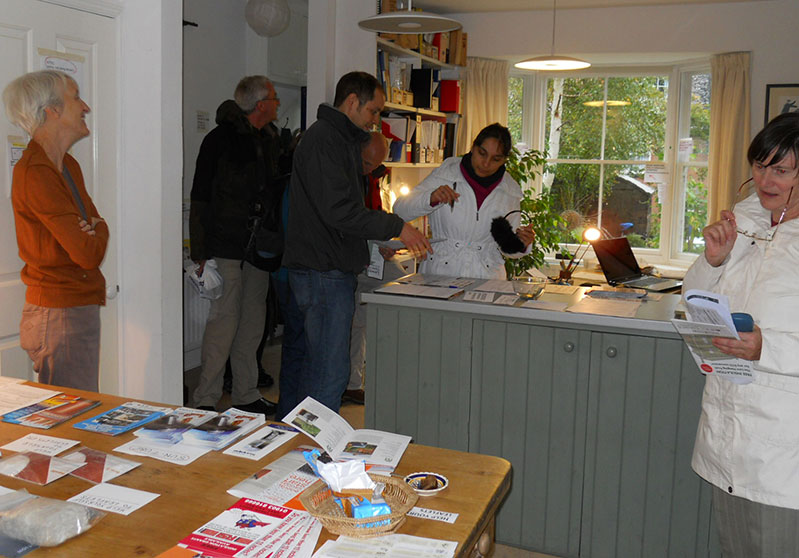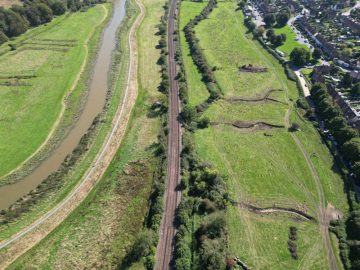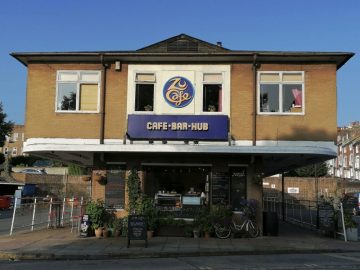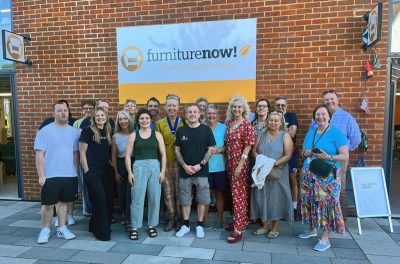Lewes Retrofit Forum at the pub Monday 7 July, 7.30pm, Lewes Arms, 1 Mount Place, Lewes...
Read More
Lewes Retrofit Forum: Installing a heat pump
Lewes Retrofit Forum: Getting ready for installing a heat pump Thursday 13 March 2025, 7.30pm-9pm, Lewes...
Read MoreLewes Retrofit Forum
Lewes Retrofit Forum Thursday 30 January 2025, 7.30pm-9pm, Lewes Climate Hub (Ovesco Energy Room), Lewes House,...
Read MoreLewes Urban Arboretum in action
Lewes Urban Arboretum in action The tree-planting season has started and the Lewes Urban Arboretum team...
Read MoreBorrow a Thermal Imaging Camera
Borrow a Thermal Imaging Camera Do you want to know where heat is escaping from your...
Read MoreLewes Home Retrofit Guide launch for building professionals
Lewes Home Retrofit Guide launch for building professionals Thursday 21 November, 6-9pm, Lewes Climate Hub, 32...
Read MoreBuilding policy in Lewes district
Where and how many new buildings are built is determined by the National Planning Policy Framework (NPPF), which sets out government’s planning policies and how these are expected to be applied. It includes meeting the challenge of climate change, flooding and coastal change. The South Downs National Park Local Plan implements the NPPF and sets out polices to meet housing and economic needs in the national park and the impact of climate change. In addition, the Lewes Local Neighbourhood Plan sets out local policies on themes such as transport and protection of the town’s heritage, potential sites for new homes and ideas for design.
How buildings are constructed is determined by Building Regulations which are set nationally. Building regulations set the minimum standards that apply to almost all new building work, including alterations to existing houses. They cover all aspects of construction including damp-proofing, insulation, ventilation, heating etc. Only minimum standards must be met; higher standards are voluntary.
Local groups involved
The Friends of Lewes is the Lewes civic society that seeks to ensure that Lewes retains its special character despite constant pressure to develop the town. It considers all planning applications affecting Lewes and makes comments to the local planning authorities. In addition to design matters, it pays particular attention to flood risk and promoting the use of permeable materials for drives and paths to reduce runoff of surface water. Where possible it engages with developers of new developments and seeks to influence them to adopt higher than minimum building regulation standards, and promotes zero carbon development. It has a watching brief on flood risk to Lewes and monitors the implementation of flood management plans by the Environment Agency and East Sussex County Council.
Lewes Eco Open Houses. Lewes’s eco householders (and those in surrounding villages) first opened their homes to the public in 2009, as a Transition Town Lewes event, and then every few years since, going virtual on Zoom in 2021. The events have aimed to encourage householders to consider what they could do to make their houses more energy-efficient, use fewer resources and generally be more environmentally friendly.
The properties, with the wide character of Lewes’s buildings, range from architect-designed eco-houses to renovated 19C cottages. They have a rich array of eco measures, often retro-fitted and at moderate cost, from insulation, draughtproofing and low-cost secondary glazing to solar power, battery storage and heat pumps. Householders also display LED lighting, water-saving features, waste recycling and simple ways to reduce electricity usage.
The Open House weekends have been brilliantly successful, with hundreds of eager visitors each time. In 2014 the visitor feedback forms showed that 86% of visitors reported intending to make their homes more energy-efficient after their visits. See below for a case-study.
Groups and contacts
Human Nature (North St Quarter redevelopment)
Ovesco: Lewes organisation creating community-owned renewable energy projects
Community Energy South: promoting community energy initiatives

Kind Construction
Sustainable builders using natural, recycled and reclaimed materials.
What can I do to help?
Most buildings in Lewes were constructed to standards that predate the integration of effective measures to reduce our carbon footprint. However, simple cost-effective measures can be taken to improve existing buildings and open spaces retrospectively to address climate change. These include:
- Insulate lofts, walls and floors
- Reduce draughts from windows and doors
- Use energy-efficient light bulbs
- Install heating controls that reduce energy use, e.g. timers, thermostats
- Install water-efficient shower-heads, taps and appliances
- Fix leaking water pipes and dripping taps
- Discharge rainwater to soakaways and disconnect clean rainwater connections from foul water drains, to reduce the energy required for wastewater treatment
- Collect water in rainwater butts for garden watering rather than using a hosepipe
- Use porous materials for hard landscaping to reduce run-off
- Plant trees in gardens and public open spaces
Case study: renovating for an eco-house
Wille Cottages in South St were built in 1898, a small brick terrace with lovely but draughty sash windows. I moved in in April 2010 after major structural and renovation work; the house now has two bedrooms and an open-plan ground floor. Most importantly, I have masses of insulation (walls, floors, ceilings, roof), plus low-cost unobtrusive secondary glazing, underfloor heating, etc. I have solar PV panels and lithium storage batteries: the latter result in tiny electricity bills and give protection in a power outage (which happens!). At a detailed level, I have isolation switches on items which otherwise stay on standby, and on appliances such as extractor fans and cooker electrics which otherwise kick in needlessly; small savings, but they add up.
My aim was to create a sturdy house which would need little short-term maintenance and would keep energy (and water) use down, while retaining its general character. Do look at my website about my green house, and my video about magnetic-strip secondary glazing (more than 100,000 hits on YouTube!).
Jill Goulder (Feb 21)


Remembering the Lewes Floods, 25 years on
All photos: @abbiestanton/abbiestanton.com Remembering the Lewes Floods, 25 years on An amazing community collaboration by Lewes Town Council, Lewes Climate...
Read MorePower Station: film screening plus director Q&A and energy drop-in sessions
Photo: Strandliners Power Station: film screening plus director Q&A and energy drop-in sessions Thursday 8 January, energy drop-in sessions from...
Read MoreRecord biobeads for Strandliners
Photo: Strandliners Record bio-beads for Strandliners You will no doubt have read about the shocking water pollution event off the...
Read More‘Citizen science’ river testing programme launched
‘Citizen science’ river testing programme launched A new programme has been launched by Love Our Ouse to monitor the health...
Read MoreMeeting with James MacCleary MP
Meeting with James MacCleary MP In October, Lewes MP James MacCleary met with representatives of Lewes Climate Hub and other...
Read MoreRight on the money: Aligning your investments with your values
photo- Freepik Right on the money: Aligning your investments with your values Lots of people come into Lewes Climate Hub...
Read MoreNew Year Plant Hunt
Corn Marigold New Year Plant Hunt Friday 2 January, 10.30am-12 noon, meet at the Linklater Pavilion, Railway Lane, Lewes, BN7...
Read MoreWelcome the Coat of Hopes to Lewes
Photo: Coat of Hopes project Welcome the Coat of Hopes to Lewes Sunday 4 January, starting at 10am in Brighton...
Read MoreBranching out to a greener bank
photo- Freepik Branching out to a greener bank So, hands up who wants to talk about banking! Probably no one,...
Read MoreTurning the tide on plastic…one Lewes Cup at a time
Turning the tide on plastic… one Lewes Cup at a time Did you know that around 80,000 single-use plastic cups...
Read MoreEnd The Great Gas Rip-Off with Greenpeace
End The Great Gas Rip-Off with Greenpeace Debbie Annells of Greenpeace Lewes introduces a new nationwide campaign demanding an electricity...
Read MoreUrge your MP to attend the National Emergency Briefing
Urge your MP to attend the National Emergency Briefing A National Emergency Briefing on the climate & nature crisis is...
Read MoreFood Season: Nourishing our Community
Food Season: Nourishing our Community Saturday 4 – Saturday 25 October, Lewes Climate Hub, 32 High Street, Lewes, BN7 2LUCome...
Read MoreNEW! Talking Rubbish with Neil Peters
Talking Rubbish with Neil Peters First Thursday of every month, drop in anytime between 12 noon and 2pm, Lewes Climate...
Read MoreNEW! Family Swap Shop with Meredith Brooklyn
Family Swap Shop with Meredith Brooklyn Second and fourth Fridays of the month, 11am-2pm, Lewes Climate Hub, 32 High Street,...
Read MoreRingmer Apple Day
Ringmer Apple Day Saturday 11 October, 11am-2.30pm, Ringmer Village Hall, Lewes Road, BN8 5QH, FREETo celebrate the 20th anniversary of...
Read MoreStarting your own Neighbourhood Coffee Collective
Nevill Coffee Collective member Andy Capie Starting your own Neighbourhood Coffee Collective A group of coffee-loving families in the Nevill...
Read MoreWe’ve invited our MP to meet – here’s why it matters
We’ve invited our MP to meet – here’s why it matters This month sees a national Mass Lobby where local...
Read MoreA Taxonomy of Climate Deniers
Image: rawpixel.com/Freepik A Taxonomy of Climate Deniers A groundbreaking new study of climate deniers had led to fascinating results, showing...
Read MoreNew wetlands project starts at Landport Brooks
New wetlands project starts at Landport Brooks Work has begun by Lewes District Council and the Ouse & Adur Rivers...
Read MoreContribute to a history of Lewes Bus Station
Can you contribute to a history of Lewes Bus Station? Prompted by the uncertainty over the future of Lewes bus...
Read MoreEncouraging ‘meanwhile’ spaces in Lewes District
Encouraging ‘meanwhile’ spaces in Lewes District With a number of shops lying empty in Lewes and elsewhere, The Makers Directory...
Read MoreFurniture Now are recruiting volunteers
Furniture Now! are recruiting volunteers Have you ever considered a role in charity retail? Do you have some free time,...
Read MoreJoin the team at Laughton Greenwood
Join the team at Laughton Greenwood Laughton Greenwood is a rare treasure – one of the few community-managed woods in...
Read More



























